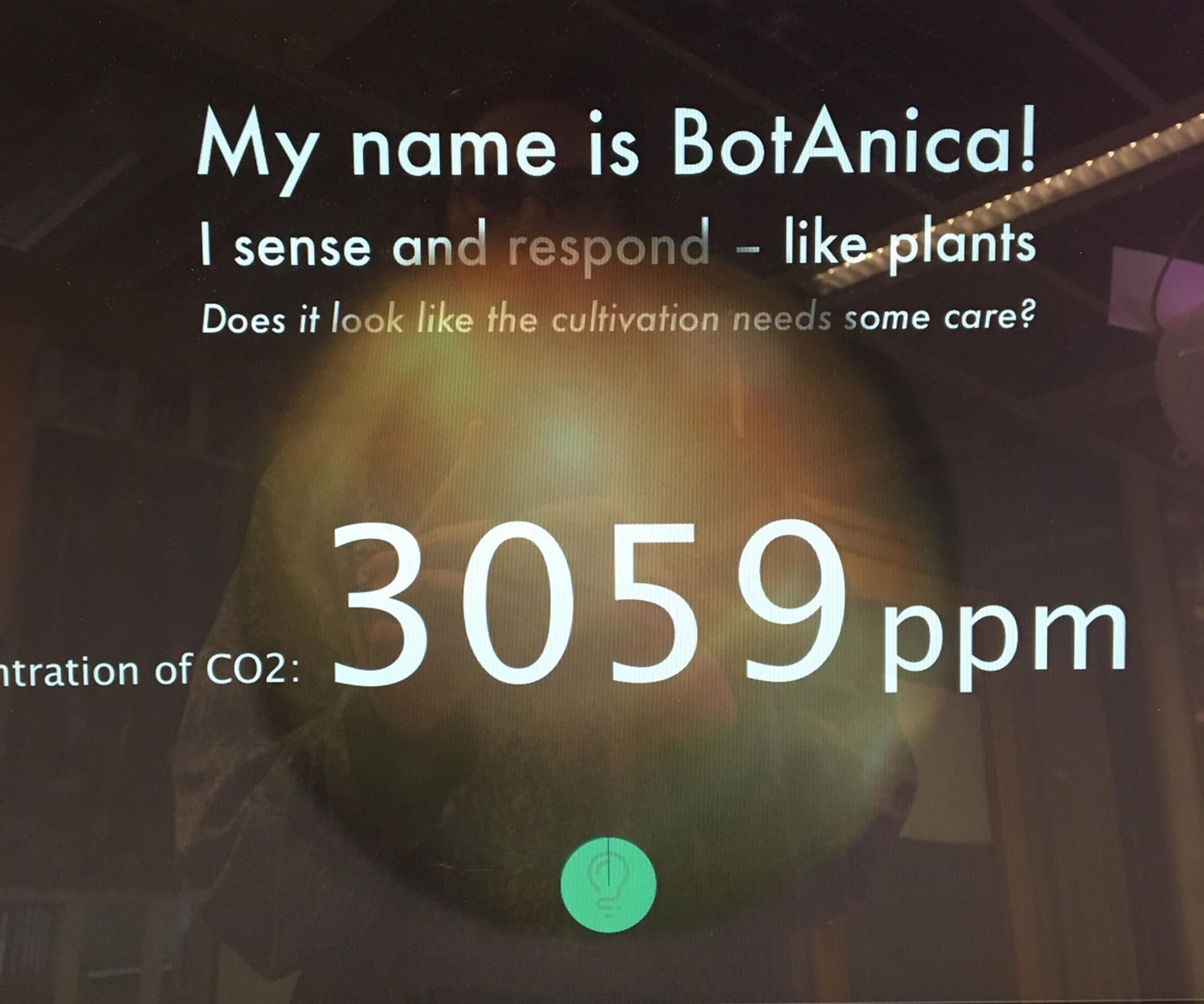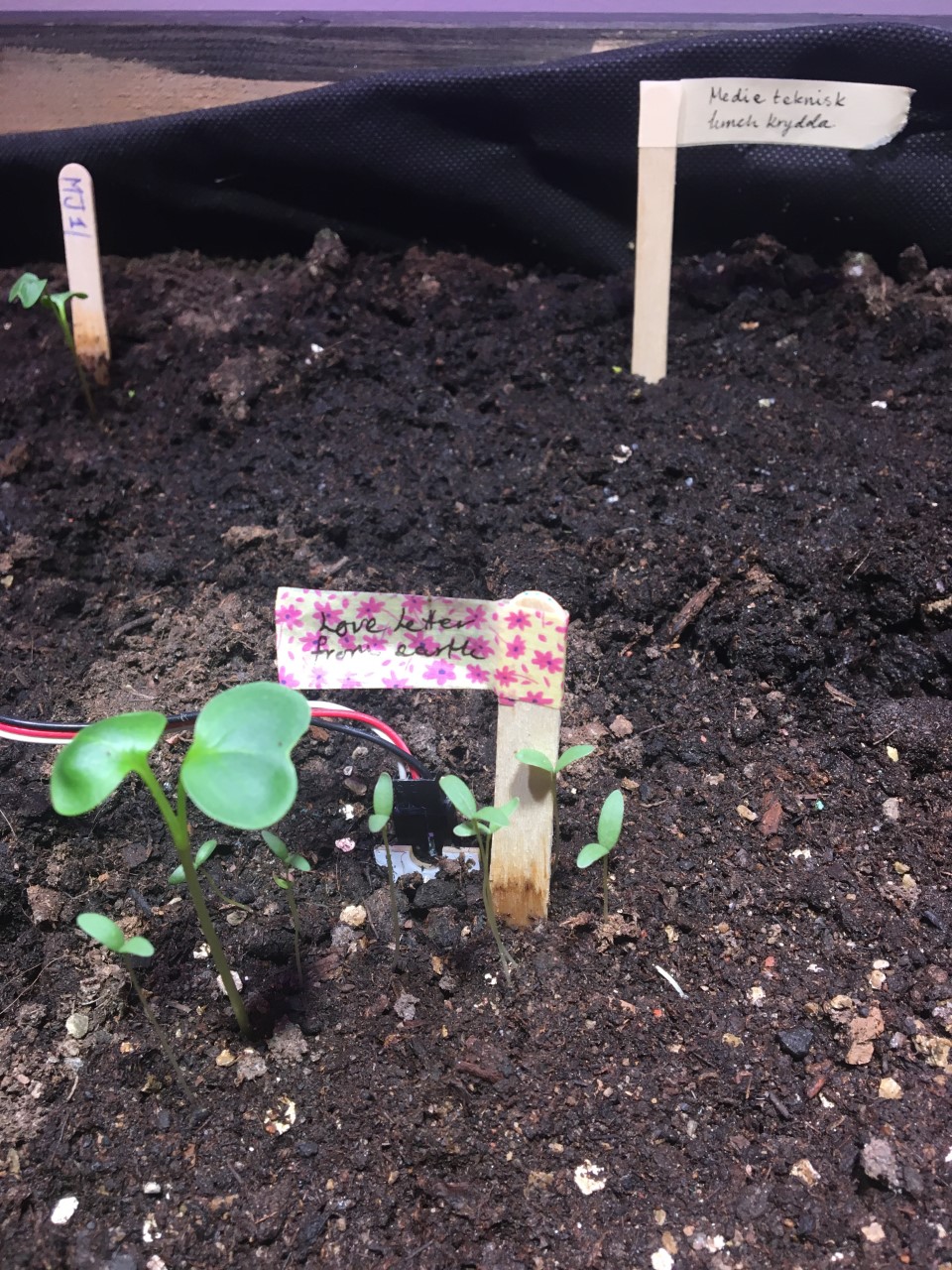BotAnica – sensorbased interaction with plants
This project explored if and how sensing technologies could be used to spur engagement towards environmental sustainability and plants. As an interaction design research project it explored more ambiguous forms of interaction and representation of environmental data. This was done through the iterative development of two functioning prototypes BotAnica and PreSense.

A user exhaling toward the funnel and CO2 sensor of BotAnica.

The protype on day 28 during the experiment.
The BotAnica prototype senses moisture, light and carbon dioxide (CO2) in a cultivation that was collaboratively taken care of in my university corridor. The data from the sensors was visualized through animations on an adjacent screen.


Left: The setup of the BotAnica system. Right: Interaction with the soil.
Design
A carbon
dioxide (CO2) sensor (Amphenol T6615-5K) was placed inside a funnel connected
to flexible tube that led down to the plants. A sign on the funnel stated, “Plants like being talked to”. The
purpose of the tube and the sign was to encourage users to talk to or exhale on
the CO2 sensor, drawing on the cultural notion that it is beneficial to ‘talk
to plants’ and breathe on them. The measured CO2-level determined the size of
an animated cloud on a screen adjacent to the cultivation. The exact
measurement in parts per million (ppm) was additionally displayed. Exhaling on
the sensor caused the measured levels of CO2 to increase significantly since an
average breath contains 4 000 ppm (parts per million) CO2, while the average
concentration in the atmosphere is 400 ppm CO2.
The visualization of a high
measurement of CO2 caused by direct exhalations on the sensor.
Messages related to the current measured concentration of CO2 were displayed. The purpose of the messages was to trigger reflection on how humans are entangled with their environment. The messages addressed effects of industrialization and climate change, human biology and health and optimal growing conditions for plants.
| 420-999 ppm: “The concentration of CO2 is rising” |
| 1000-1499 ppm: “This concentration of CO2 has been shown to yield 30% more crops.” |
| 1500-2000 ppm: “This level is associated with complaints of drowsiness and poor air.” |
| 2001-5000 ppm: “This level is associated with headaches, poor concentration, loss of attention, increased heart rate and slight nausea.” |
3900-4100 ppm: “Concentraiton of CO2 in exhale air”
Messages displayed in BotAnica
depending on measured CO2 levels.
Four moisture sensors were connected to the system and placed in the soil. Users could move these sensors to sense the moisture of a specific place. The moisture was vizualiced by animated blue cricles. High moisture was visualized with many circles with strong color. Low moisture was visualized with few circles with opaque color.
A light sensor was connected to the systems. Light was visualized similarly to moisture but with white circles.
Sensor data was collected every tenth minute, enabling tracking of environmental conditions for the whole duration of the experiment. All instances of visible interactions with the cultivation were photographed sequentially by a motion sensitive camera mounted above the cultivation.


In the lefft image the signs state “Love letter from Lartte” and “mediatechnological lunch herb”. In the right image circles indicate moisture sensors, squares indicate signs.
BotAnica was set up in the corridor of my department of media technology for the duration of four months. A sign was mounted on the cultivation in order to encourage interaction with the cultivation “This cultivation is taken care of by everyone passing by. Take care of it!”. Seeds were provided to all occupants (28) of the office in order to encourage planting and caring of their own – and others – seeds.
A time
lapse video of the interactions with the cultivation of botanica.
![]()
The complexity of both explicit and implicit interactions related to the system.

The complexity of both explicit and implicit interactions related to the system.
Insights:
-
Sense the imperceptible. Users were not vety interested in data abut phenomena which they could precive (e.g, moisture and light. They were more interested in data about phenomena that they could not perceive (e.g, CO2). There is an opportunity to further
explore other ‘imperceptible matter’ in the environment (e.g, soil nutirents and pollution), and how they could be
sensed or designed with.
-
Let users interpret data themselves. Users
preferred to make their own interpretations of data, and hence favored
numerical representations of sensed data, over both ambiguous representations
(animated visualizations) and explicit interpretation (messages with facts tied
to the sensed CO2 level). Although ambiguity was appreciated as an important quality
of the overall interaction with the prototype, the users expressed that they
did not want the representation of data to be ambiguous. Instead, they wanted
the data to be presented numerically in order to make their own (ambiguous) interpretations.
-
Inherent meaning in the act
of sensing. The
mere act of sensing spurred more interest and engagement towards the
cultivation than the actual data itself. There is an opportunity to further explore
how the actual process and experience of measuring and sensing the environment
could be designed for in a richer way.
- Withstand rough environmental conditions. The sensors corroded and stopped working. Technology in a wet biological setting needs to be robust. An outdoor context is even more challenging.
- Obstructive qualities of technology. The sensors acted as an obstructive layer between the users and the cultivation, prompting users to interact with the sensors, instead of the plants.
- Implicit interaction. It seems more accurate to claim that people were affecting and being affected by the design rather than ‘using’ the system in a classic sense. This points at the need to further explore technologies that act in the background or pheripery op our experience. These background technolgies shape the environment of an experience rather than being directly interacted with. This illustrates how f the notion of “a user” needs to be reconsidered in a more than human-centered context.
-
Interaction beyond technology. The richest interaction with the
‘system’, in terms of user experience and perceived meaningfulness, was not
that guided by technology, but that involving direct engagement with the soil, plants,
insects and other humans. Examples inclue sticking fingers in moist soil, or
discussions about the cultivation with others.
- Embracing the unexpectedness of biological processes. Some of the most meaningful experiences of the system were not planned beforehand. For example, fruit flies emerged as a concsequence of having the cultivaion in the coridor. This became a subject of discussion that triggered the participants to discuss the role of nature in their everyday life. The temporality of biological processes was furhter appreciated by participant of the study. For example, the rytmic temporality of breathing or the relatively slow proces of growing. Biological processes were often framed as slower than the temporality of conventional interaction design and technology. Ther is thius an opportunity to align the tempo of interaction eagin, with the tempo of sloweer biollogical proceses. The positives effects on health of such an aporahc was higlighted by the participants.

C02 cycles. Human breathing is in the center. The technologies of BotAnica and the ventilation are part of the cycle. The cycles are disrupted by
combustion of fossil fuels
In sum, the design work with this prototype highlighted the relational entanglement of humans (and their social relations), plants (and how they were cared for), air molecules (and how they were connected to climate change as well as photosynthesis), electric currents, sensors, screens, soil, water etc. All these entities seem to interact with each other, and shape various forms of meaning. More-than-human-centered design provides the analytical structure to discuss these entanglements.
— AQQ